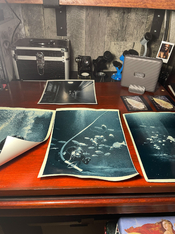Photopathe
Member
I started direct blue toning and I have some issues and questions. I was able to find Tim Rudman's Toning Book and I also have been reading on the web so I did my homework before posting.
My main issue is with fixer. Tim Rudman advices to fix the print after tonging to avoid degradation of the image mid-term (am passing on the chemical process details here). My first attempt was a failure as I forgot not to use my usual fixer (neutral/alkaline TF-5). I then prepared some Kodak F-24 acid fixer following Steve Anchell's Cookbook. I was curious and tried the full strength fixer and it messed up the colours and tones. Then, as per the recommandations, I diluted it 1:10 with distilled water and fixed the toned print for 30 seconds. The fixing stage still messes up the tones and colours. Colours shift to a weird and unpleasant pale turquoise and the light tones are getting too clear. It looks a little like some mild Sabatier effect I think. I read an article were the author gave up on fixing after iron toning stating that he yet has to see any degradation (some tones turning brownish) from skipping the post-toning fix. If anyone could share experience and advices about this it would be greatly appreciated.
I am also unsure about some other elements of the process. I am using a slightly acidic stop bath right after toning (1L tap water + 10ml white vinegar). It this really useful if I am to wash in running tap water afterward? Isn't it more useful to just give a final dip in this acidic stop bath just before hanging to dry? Also, if I use a 0.2% borax or 0.2% bicarbonate bath to have the colours shift towards blue/navy-blue after the final wash is it ok to go straight to drying afterward? If I am to wash again after the alkaline bath (Borax/Bicarbonate) there is again a colour shift.
Thanks!
My main issue is with fixer. Tim Rudman advices to fix the print after tonging to avoid degradation of the image mid-term (am passing on the chemical process details here). My first attempt was a failure as I forgot not to use my usual fixer (neutral/alkaline TF-5). I then prepared some Kodak F-24 acid fixer following Steve Anchell's Cookbook. I was curious and tried the full strength fixer and it messed up the colours and tones. Then, as per the recommandations, I diluted it 1:10 with distilled water and fixed the toned print for 30 seconds. The fixing stage still messes up the tones and colours. Colours shift to a weird and unpleasant pale turquoise and the light tones are getting too clear. It looks a little like some mild Sabatier effect I think. I read an article were the author gave up on fixing after iron toning stating that he yet has to see any degradation (some tones turning brownish) from skipping the post-toning fix. If anyone could share experience and advices about this it would be greatly appreciated.
I am also unsure about some other elements of the process. I am using a slightly acidic stop bath right after toning (1L tap water + 10ml white vinegar). It this really useful if I am to wash in running tap water afterward? Isn't it more useful to just give a final dip in this acidic stop bath just before hanging to dry? Also, if I use a 0.2% borax or 0.2% bicarbonate bath to have the colours shift towards blue/navy-blue after the final wash is it ok to go straight to drying afterward? If I am to wash again after the alkaline bath (Borax/Bicarbonate) there is again a colour shift.
Thanks!












